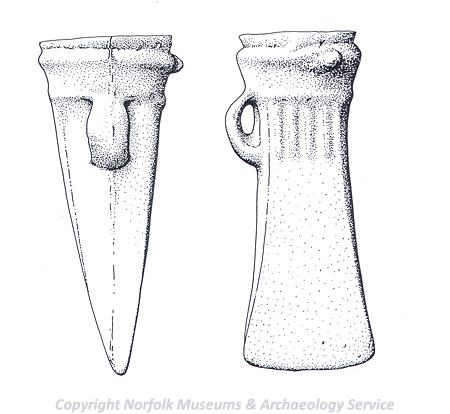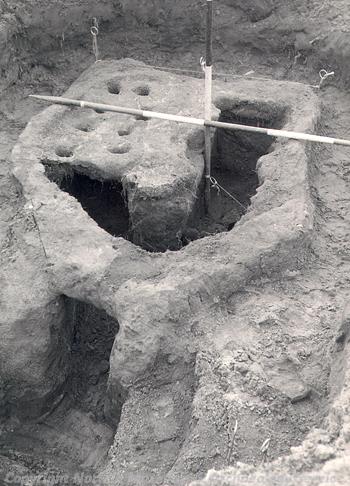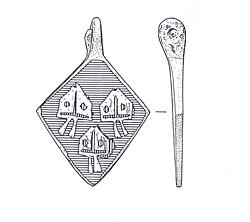This Parish Summary is an overview of the large amount of information held for the parish, and only selected examples of sites and finds in each period are given. It has been beyond the scope of the project to carry out detailed research into the historical background, documents, maps or other sources, but we hope that the Parish Summaries will encourage users to refer to the detailed records, and to consult the bibliographical sources referred to below. Feedback and any corrections are welcomed by email to heritage@norfolk.gov.uk
Hevingham is in the Broadland district of Norfolk. It is located north of Norwich between the parishes of Marsham and Stratton Strawless. The village name has Old English origins and is translated as ‘homestead of the people of Hefa’. The village is documented in the Domesday Book where one freeman, a priest, is recorded as holding 40 acres in alms for the King. He sings ‘three masses in any one week’. This is interesting because later in the medieval period a bishops’ palace was built in the parish. The village of Rippon or Ripton is noted within Hevingham but this village was deserted during the medieval period. Its exact location is not clear.

A Bronze Age hoard found in Hevingham included this socketed axehead. (© NCC.)
The earliest archaeological find recorded is a Mesolithic flint axehead (NHER
7632). Several Neolithic flint axeheads (NHER
7496,
7515 and
7757) have also been recovered. A Neolithic flint scraper (NHER
37676) has been found. A Beaker period barbed and tanged flint arrowhead (NHER
7633) also comes from the parish. These finds are evidence of activity, but the earliest sites belong to the Bronze Age. The sites of several possible Bronze Age round barrows (NHER
7516,
7500,
36071 and
7498) have been identified. Bronze Age copper alloy axeheads (NHER
7499 and
39746) including an incomplete example (NHER
35836) and a copper alloy palstave (NHER
33248) have been found. Metal detecting recovered a very exciting Late Bronze hoard (NHER
36973) containing a mould for a socketed axe, two socketed axes, a cutting edge and a socketed hammer. This may have been left behind by a metalworker. Two possible Iron Age terrets (NHER
39947 and
42542) have been recorded. One of these dates to the 1st century BC and the other may be Iron Age or Roman.

A Roman pottery kiln excavated in the 1950s. (© NCC.)
There is more evidence of Roman activity. A possible Roman ironworking site (NHER
7495) was found during ploughing and was subsequently excavated. Archaeologists also investigated pottery kilns (NHER
7498) in the parish in the 1950s. Five kilns were recorded. These produced mortaria and other coarse pottery during the 2nd century AD. The names of two potters who worked at the site – INGENU and ESAMI are recorded on the stamps they used on their pottery. The Neolithic axehead found inside one of the kilns was probably placed there as a good luck charm. A possible Roman road (NHER
36468) has been identified on aerial photographs close to the pottery works. Metal detecting in the parish has also recovered a wide range of interesting Roman finds including coins (NHER
18512,
28436 and
37476), a possible coin blank (NHER
29292), a cosmetic mortar (NHER
33098) used for grinding make up and part of a snake bracelet (NHER
4687). Brooches (NHER
33553 and
37676) and pieces of pottery (NHER
7633,
28514 and
37713) have also been found.
Metal detectorists have recovered all the evidence we have for Saxon Hevingham. An Early Saxon brooch (NHER 28514) and a 7th century decorated bar mount (NHER 29292) are the earliest finds. An unusual boss or false rivet from an Aquitanian style Early to Middle Saxon buckle (NHER 41316) was also found. This depicts a stylised head. Two Middle Saxon brooches (NHER 41687 and 29292) have been recorded. One of these depicts an animal looking backwards (NHER 29292). Animals are also depicted on the terminals of two Late Saxon strap ends (NHER 36544 and 41687). Two pieces of a Late Saxon mount (NHER 29292) have also been recovered. Amazingly these can still be fitted together.

A medieval horse harness pendant from the site of a medieval Bishops' Palace. (© NCC.)
The medieval bishops’ palace (NHER
7656) in Hevingham was built by Bishop Walter de Suffield of Norwich in 1250, but the Domesday Book records the earlier presence of clergy in the parish. Earthworks of the moated site can still be seen. Hevingham Park (NHER
39747), a medieval wood, may have been a deer park and rabbit warren connected to the palace. The presence of the palace explains the recovery of two papal seals (or bulls) (NHER
33275 and
39539) in the parish. One of these was used by Pope Paul II (1464 to 1471) (NHER
39539) and the other by Pope Clement VII (1523 to 1534) (NHER
33275). St Botolph’s Church (NHER
7661) was mainly built in 1300, but parts of the church may date back to the Norman period. It may have been here that the priest held his thrice weekly masses. The medieval village of Rippon or Ripton (NHER
7653) may be located close to Rippon Hall but its exact location is not clear. The site of a camping ground, or recreation field, where a ball game similar to football was played may be recorded in the modern names of Camping Beck and Camping Bridge (NHER
7525). Medieval finds include several coins (NHER
18511,
41089 and
41980). A Spanish medieval coin (NHER
41316) has also been recorded. A pair of copper alloy dividers (NHER
28436) was found near the church and the leg of a medieval cauldron (NHER
30072) has also been recovered. Two medieval seal matrixes (NHER
30448 and
33578) depict similar designs – the lamb and flag. One of these is inscribed in Latin (NHER
30448). The inscription can be translated as ‘Lamb of God be with you’.
The sites of several post medieval buildings including a brick kiln (NHER 15926) and a smock mill (NHER 15929) have been recorded. There are also many standing post medieval buildings. Park Farm House (NHER 43102) is a 16th century house built just outside the site of the bishops’ palace after the Dissolution. This is likely to be the medieval manor that replaced the palace. Pound Farm House (NHER 21865) was built slightly later in 1675. The Rectory (NHER 43104) was built in 1788 for Reverend J. Alderson. Avenue Farm House (NHER 43101) dates to 1835. A possible post medieval witch bottle (NHER 28977) has been found in a garden. The 17th century pottery Bellarmine jar contained several iron nails. Two very rare post medieval finds have also been made. Whilst lead cloth seals are relatively common finds the cloth seal matrix (NHER 39724) found in Hevingham is a much more unusual discovery. The second find, a 17th or 18th century meat seal (NHER 40679), was used by kosher butchers to guarantee the animals had been killed according to Jewish law.
The only modern archaeological building recorded in the database is a World War Two pillbox (NHER 14151).
Megan Dennis (NLA), 22 February 2006.
Further Reading
Brown, P. (ed.), 1984. Domesday Book, 33 Norfolk, Part I and Part II (Chichester, Philimore)
Mills, A.D., 1998. Dictionary of English Place Names (Oxford, Oxford University Press)
Rye, J., 2000. A Popular Guide to Norfolk Place-names (Dereham, The Larks Press)
Unknown, unknown. 'Hevingham Village – Our Web’. Available:
http://www.btinternet.com/~hevingham/index.htm. Accessed: 22 February 2006.
Whittle, J., 1998. ‘Individualism and the family-land bond: a reassessment of land transfer patterns among the English peasantry c. 1270-1580.’, Past and Present, August.